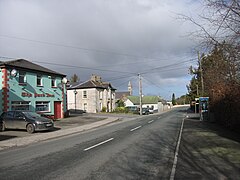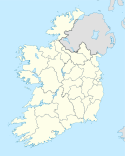Emo (Irlandia)
| ||
 Główna ulica w Emo | ||
| Państwo | ||
| Prowincja | Leinster | |
| Hrabstwo | Laois | |
| Populacja (2011) • liczba ludności | 245 | |
Emo (irl. Ioma) – wieś w hrabstwie Laois w Irlandii. Położona jest niedaleko Portlaoise przy drodze R422 tuż przy autostradzie M7 na linii Dublin–Limerick. Liczba ludności: 245 (2011)[1].
Zabytki
Neogotycki katolicki kościół, w którym znajduje się marmurowy sarkofag hrabiny Portarlington Aline[2], z jej podobizną dłuta austriackiego rzeźbiarza Josepha Edgara Boehma (1834–1890).
Neoklasycystyczny dwór w Emo (ang. Emo Court)[3] – wiejska rezydencja (ang. country house, mansion) zbudowana dla Johna Dawsona (1744–1798), pierwszego earla (hrabiego) Portarlington w roku 1790 przez Jamesa Gandona, architekta znanego w Irlandii z projektów takich dublińskich budynków jak Four Courts, Custom House czy King's Inns.
Nazwy pochodzące od wsi Emo
W Ontario w Kanadzie irlandzcy emigranci pochodzący z tej okolicy założyli miasto o tej samej nazwie Emo.
Od nazwy wsi pochodzi również nazwa Emo Oil Company z siedzibą w Portlaoise, która jest dystrybutorem paliw na terenie Wielkiej Brytanii i Irlandii Północnej.
Zobacz też
Przypisy
- ↑ Census 2011 Preliminary Report (ang.). 2012-04-30. [dostęp 2012-12-23].
- ↑ Aline Countess of Portarlington (1823-1874) (ang.). [dostęp 2011-10-17].
- ↑ Emo Court and Gardens (ang.). [dostęp 2011-10-17].
Media użyte na tej stronie
Autor: Kanchelskis, free hand work., Licencja: CC-BY-SA-3.0
County Laois crest.
Toponomastica: L'attuale nome Laois (da pronunciare nella nostra lingua lish) è il nome gaelico di quella che una volta era la Queen's county ("contea della regina"), e significa letteralmente "chiesa nei pressi della quercia".
Da notare che anche le forme anglicizzate Laoighis e Leix sono corrette.
Araldica civica
Lo stemma del Laois è uno scudo dorato con un nastro contenente vari elementi distintivi.
- la V rossa capovolta (chevronels): rappresenta la catena montuosa delle Slieve Bloom Mountains e la Rock of Dunamaise, mentre i simboli bianchi in essa contenuti rappresentano le 7 tribù antiche locali principali.
- le due sfere ondulate (fountains): rappresentano i due fiumi principali della contea, il Nore e il Barrow e i due colori tradizionali e sportivi della contea (bianco-blu)
- il leone: l'animale su sfondo dorato era l'emblema degli antichi King of Laois, gli Ó Mordha.
Il nastro invece riporta il motto in gaelico "L bÁirt leis an bpobal" che significa "Insieme con il Popolo".
Bibliografia:
(c) sarah777, CC BY-SA 2.0
Emo, County Laois, near to Emo, Kennel Cross Roads, New Inn Cross Roads, The Togher and Carn Bridge, Laois, Ireland. Excellent topiary.
Autor: Tom Cosgrave, Licencja: CC BY-SA 2.0
Emo Court, located in the village of Emo in County Laois, Ireland, is a large neo-classical mansion, formal and symetrical in its design and with beautifully proportioned rooms inside. It was designed by the architect James Gandon in 1790 for John Dawson, the first Earl of Portarlington. It is the only house to have been designed by Gandon. Other buildings by him include the Custom House and Kings Inns, both in Dublin.
The approach to Emo Court today begins through a rather unobtrusive gateway. Within the grounds, a road runs for some distance through a beech wood which opens suddenly to give a view to the right of the house and the Wellingtonias which now line an abandoned avenue. Visitors are directed to a car park at the side, so that the house and its trees are preserved free from cars and from a goodly share of the 21st century. To the left are coach houses and servants’ quarters, to the right beautiful mature trees and in the centre the entrance front, dominated by a pediment supported by four graceful Ionic pillars. The Earl’s coat of arms fills the pediment and, to left and right, are 18th century friezes depicting agriculture and the arts. Heraldic tigers guard the steps.
The gardens at Emo are magnificent and they too have been brought back to the splendour of their past, with formal areas, woodland walks, abundant statuary and a lake. They are divided into two main areas. The Clucker, which contains some fine and rare specimen trees and a vast range of azaleas and rhododendrons and other shrubs. This part of the garden is at its magnificent best in late Spring. The Grapery is an arboretum though which wind a series of pathway, each opening to vistas across the surrounding Slieve Bloom mountains or towards the house. This is a marvellous place to visit in Autumn especially when it is a blaze of dramatic colours.








